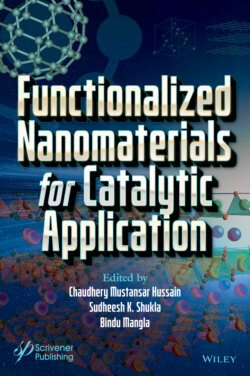Читать книгу Functionalized Nanomaterials for Catalytic Application - Группа авторов - Страница 27
1.6 Nanocatalyst Antimicrobials as FNMs
ОглавлениеFNMs as nanocatalyst have been authenticated with a promising note for cleansing and sanitization treatment for a mixture of waste and normal water from different sources. With an excellent potentiality to inactivate the active disease-causing dreadful pathogenic micro-organisms like fungi, bacteria, and viruses, FNMs behold their role to safeguard the water bodies. Increase in the potential momentum for anti-microbial activity is efficaciously observed by surface alterations of NPs [211]. Functionalized photocatalytic materials are appropriate tools for curbing the unwanted horrible [212]. Disinfection rate of pseudo-1st-order rate kinetics for retarding activation of E. coli was observed to be 86% in 4 h by FNMs (C60/C3N4 | C70/C3N4) on photocatalytic treatment [213]. Similarly, 2D g-C3N4 NS/PAN hydrophilic filter membranes, demonstrated for excellent self-cleaning and anti-bactericidal action over E. coli, by photocatalytic visible light were proven to have 100% sterilization efficiency at optimized (12 h) condition with a restoration capacity to about three rescalable cycles [214]. The existence of the hindering polymeric substances on pathogens that retard the anti-microbial photocatalytic efficacy is to be negated for water disinfections, in a momentous scale [215].
Visible light illuminations are powerful in inhibiting the bactericidal action by the photo-generated peroxides from g-C3N4 NS [216]. In an anti-bacterial work, the co-workers defied the potent E. coli, by Ag/TiO2 film, using photocatalytic fluorescent light radiation for 3 h. A total of 81% deactivation was observed, due to the release of Ag+ ion, and the trapped photo-induced e−, h+, that diffuse on the catalytic surface to inhibit the activity of the target species [217]. Hence, the cell wall membrane of bacteria is disrupted by the photo-generated e− leading to reductive cell damage thereby deactivating the bacterial activity. gC3N4-BiFeO3-Cu2O FMNs by photocatalytic decomposition using visible light suppressed the activity of the bacterial stains, S. aureus (G+) and E. coli (G−) in ambient reaction condition [218]. In some reverse trials, the bacterial E. coli affecting the water bodies when functionalized with TiO2 as cocktails promoted the deactivation of the bacterial E. coli and S. epidermidis [219]. Abundant trials have made their way to upsurge the usefulness of FNMs as nanocatalyst, as anti-microbials by optimized advancement with molecular modifications with resourceful materials.
